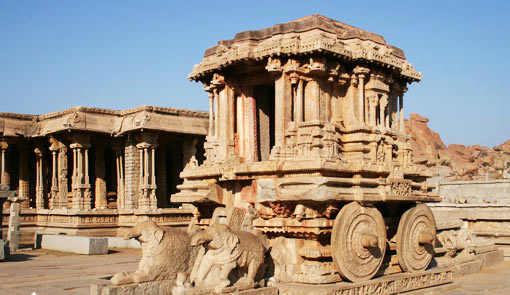Name of the Temple |
- Virupākṣha Temple or Pampapathi Temple
|
Location |
- This temple is located on the south bank, Hampi, of the river Thungabhadra Karṇātaka, South India
|
| How to reach there? |
- By Air: Bellary Airport is the nearest domestic airports to reach Hampi Virupākṣha Temple. The airport is 75 km east of Virupākṣha. Take from Bellary the National Highway 63 and the State Highway 29.
- By Train : Hospeṭ Junction Railway Station, served by South Western Railways, is the nearest railway station to reach Hampi Virupākṣha Temple. Hospeṭ Railway Station is just 13 km from Hampi city. From the station take the State Highway 131 north-east.
- By Road : Hospeṭ town (13 km) is the main entry point to the historic Hampi city in Karnāṭaka. Hampi is 175 km from Bādhāmi, 199 km from Paṭṭadhakal, 161 km from Hubḷi, 124 km from Aihoḷe, and 464 km from Haidherabādh. National Highway 63 from Ankola to Gūṭi passes just close to Hampi city.
|
Rulers/builders and Time Period
|
- The very origin of Hampi’s history as a sacred place revolves around the myths associated with this temple. It believed that this temple has been functioning uninterruptedly ever since its inception in the 7th century AD. That makes this one of the oldest functioning temples in India.
- The original worship place was only a few separate humble shrines (believed to be as old as 7th century) housing the image of the god and the goddesses. The temple traces its origin in the first half of the fifteenth century; however it was refurbished by Kriṣhṇadevarāya in the 16th century.
- In the 14th century, Hampi used to make the royal capital and major religious center of the Vijayanagar Empire, one of the greatest empires of the world.
- The shrine is completely untouched by the destruction that was seen by many monuments in the 16th century.
|
Deities’ - Goddess |
- The temple is dedicated to Virūpakṣheśhwara (Pampapathi - a form of Lord Shiva) and Lord Viṭṭhala
|
Architecture Style |
- The progressively diminishing superstructure is made with brick and mortar. All around the exterior of the first tier spots many interesting stucco figures. This east facing giant tower (Gopura) leads you the first courtyard of the temple complex.
- This pastel painted 9 storied tower with a pair of cow horn like projections on top is the most prominent landmark in Hampi. The lower two tiers of the tower is made of decorated stone work.
- Virūpākṣha Temple has three towers, where the eastern tower rises to 160 feet with nine tiers. Sprawled in the area of about 26 kms, Hampi is akin to an open-air museum of temples. The hoary ambience of this site gets enhanced with its rugged setting.
- Just next to your left immediately after you have entered, you can see the unusual triple headed Nandhi (bull statue). Behind this the wall is painted with a large map of Hampi with the main attractions marked. The three storied tower built in 1510 AD is known after its patron, Kriṣhṇadhevarāya , one of the famous kings of the empire. The western end of the south cloister spots a rectangular opening on the floor.
- A shrine is located underground. A Nandhi is positioned near the opening. Near to it is a huge stone urn with decorations. Towards the end you can see a pair of metal bells and a large leather clad percussion instrument.
- The mural panel on the central portion of the hall is one of the few remains of this form of Vijayanagara art. Most of it is based on godly themes except the one at the eastern end.
|
Special Reference to Fine Arts in the temple |
- Several of Śhiva's manifestations, and the ten incarnations of Viṣhṇu are portrayed here, as is the classic scene from Mahabharata depicting Arjuna's shooting the fish device in order to secure Dhraupadhi's hand in marriage.
- There is also a mural depicting Vidhyāraṇya, the spiritual founder of Vijayanagar in procession. The annual Purandharadhāsa Arādhhana Music festival at Viṭṭhala Temple to celebrate the birth anniversary of the medieval poet-composer, Purandharadhāsa is also held here
|
Other Spl. Features |
- Virūpākṣha temple is the oldest and the principal temple in Hampi. It is believed that it was the place known as 'Kiṣhkintha' (stated in Rāmāyaṇa ), where Lord Hanumān was born.
- Situated on the banks of Thungabhadra River, Hampi houses the renowned Virūpākṣha and Viṭṭhala Temples of India. The murals depict various scenes from the epics of Rāmāyaṇa and Mahābhāratha. In the close proximity of Virūpākṣha Temple, one can see numerous ruined manṭapas.
|
Any Other/Remarks |
- Pampa, who is believed to be the daughter of Brahma, is the divine consort of Virūpākṣha. There is an ornamented shrine that is dedicated to Bhuvaneśhwari.
- There is also a shrine for Vidhyāraṇya, the spiritual founder of Vijayanagar. In the inner prakāram, there are shrines and pillars that date back to the 12th century.
- The temple walls are adorned with manifested images of Śhiva and Viṣhṇu.
|
Special Reference to Performing Arts |
- The Purandharadhāsa Manṭapa is an elevated pavilion found near the Vijaya Viṭṭhala temple.
- According to a popular folklore, the great saint poet Purandharadhāsa who is known to have composed about 75,000 songs once upon a time, sat here and sang songs in praise of his favourite god, Viṭṭhala.
- The poet’s songs are sung even today, most popularly in the state of Karnataka. But, since none of his songs were written down, most of them have been lost and only about a thousand odd are known to exist.
|
Bibliography |
|















